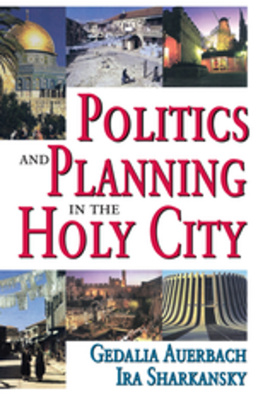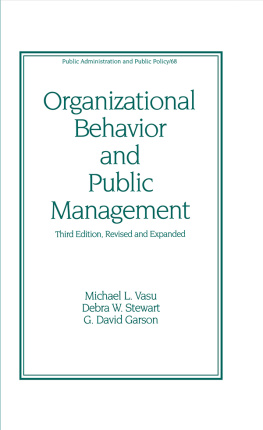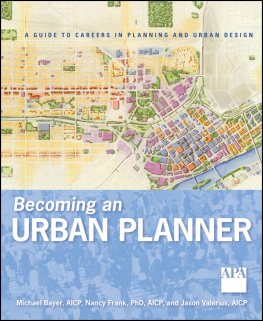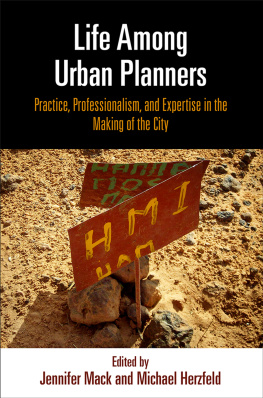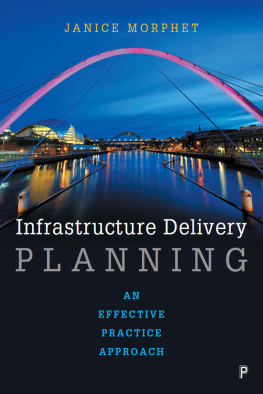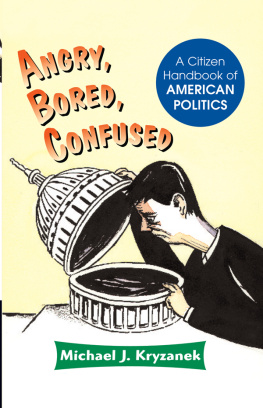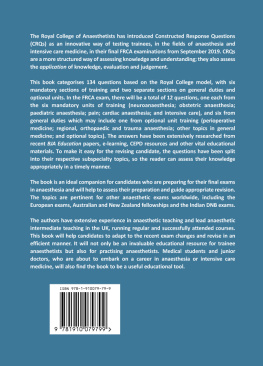1979 The University of North Carolina Press
All rights reserved
Manufactured in the United States of America
ISBN 0-8078-1342-7
Library of Congress Catalog Card Number 78-10440
Library of Congress Cataloging in Publication Data
Vasu, Michael Lee.
Politics and planning.
Bibliography: p.
Includes index.
1. Land use, UrbanUnited StatesPlanning. 2. City planningUnited States. 3. United StatesSocial policy. 4. Planning. I. Title.
HD205 1979.V37 309.2120973 78-10440
ISBN 0-8078-1342-7
Foreword
A glance at any community newspaper is likely to show stories with such headlines as: City Planning Commission to Meet, Planners Schedule Hearing to Consider Highway Relocation, or Citizens Group Protest Plan for Rezoning. At the state level increasing attention is given to planning, whether for industrial growth, growth management, or for a better quality of life. Even in the national government, where planning was long an unpopular word following the demise of the National Resources Planning Board in the 1940s, the new Department of Energy is charged with preparing a National Energy Plan; the highway plans for the Department of Transportation have had enormous impact, intended and unintended, on life in America; and the first steps at least have been taken within the Department of Housing and Urban Development toward comprehensive national urban planning.
Who are these planners? Where do they come from? By what values do they live and work? These are some of the questions that Michael Lee Vasu addresses in Politics and Planning: A National Study of American Planners. The core of the study is a unique data base: the results of a national mail survey of a cross section of the membership of the principal association of planning professionals, The American Institute of Planners. This survey was conducted by Vasu while he was a research associate of the Institute for Research in Social Science and the data are available for further, secondary analysis by others through the Institutes Social Science Data Library. By themselves these data permit a description and interpretation of the profession, and an identification of points of agreement and disagreement among planners. In comparison with data for national samples of the whole population, comparisons that Vasu supplies, the data locate a planning elite by reference to the population that elite serves.
As a study of an important American professional group, this volume should be of interest to multiple audiences. Most obviously, it will be of interest to those seeking to understand the nature of the contribution that the people we call planners make to those important policy decisions we call planning. In this sense the study contributes both to our understanding of what now is, and also of what will be, as professional planning continues to grow in importance. On these subjects Vasu has conclusions to draw and an argument to present; one of the attractive features of the book, however, is the authors ability to separate his personal evaluations from the conclusions that follow directly from the data analysis, thus permitting others with other value premises to incorporate his findings into their own conceptions of correct policy.
Secondly, the study will be of interest to those engaged in the professional training of planners. Planning is one of those professions in which some planners receive formal training as such, while others slip into service by circuitous routes. By comparing the differences in values and behaviors of those formally trained as planners with those without such indoctrination, Vasu points to some conclusions as to the current status of planning as a defined academic subject.
Finally, as a study of a major American professional group the volume should be of value to all those concerned with professionalization and the comparative study of professions. Many comparisons suggest themselves, whether to lawyers, educators, journalists, public policy analysts, or whatever; to me one of the most interesting parallels is found in the self-study of the profession of landscape architecture conducted but a few years ago.1 As the parent professionof Frederick Law Olmsted and many othersfrom which planning schismatically withdrew, landscape architecture defines a professionalization with many similar interests but subject to quite different economic influences. Fortunately, the American Society of Landscape Architects self-study made use of similar survey techniques and facilitates comparative examination.
With this book the Institute for Research in Social Science launches a new series of studies in social science to be published by The University of North Carolina Press under the joint sponsorship of the Institute and the Press. As director of the Institute I am delighted thus to resume a relationship with The University of North Carolina Press that has been so often productive of quality publication and sound scholarship through the fifty-five years since the foundation of the Institute for Research in Social Science by Howard W. Odum in 1924.
Frank J. Munger
1. Albert Fein, A Study of the Profession of Landscape Architecture (American Society of Landscape Architects, McLean, Va., 1972).
Acknowledgments
In the course of this undertaking, I have incurred numerous debts to individuals who contributed their time, expertise, and encouragement to this research. Most of these debts cannot be adequately repaid. Nonetheless, I want to express my sincere thanks to those people who have made this research both a pleasure and a reality. I hasten to add, of course, that while these individuals share whatever merit the book contains, its inadequacies are my responsibility alone.
I am particularly indebted to Professor Frank Munger, Director of the Institute for Research in Social Science (IRSS) at the University of North Carolina at Chapel Hill, for the institutional support that made this research possible. Angell Beza, Associate Director for Research Design for the Institute, was extremely giving of both his time and expertise in the sampling and design phases of this study. The staff of the Statistical Laboratory at IRSS, in particular Bill Reynolds, is owed a special thanks for their assistance in a variety of computer-programming and methodologically related concerns. David Kovenock, Director of the Comparative State Elections Project at the University of North Carolina at Chapel Hill, availed me of his considerable experience in conducting large-scale-survey research, as well as his expertise on matters of both analysis and style. I thank Elizabeth Martin, Associate Director of the Louis Harris Political Data Center at UNC Chapel Hill, for her assistance in the use of various data sources, as well as her methodological advice during the context of the study. Needless to say, neither Dr. Martin nor any of the organizations whose data I utilized are responsible for my analysis or interpretations. Susan Clarke, Director of Research Programs for the Institute, provided me with her professional assistance, scholarly encouragement, and her friendship throughout the entire course of the project. All of her contributions are highly valued. Various individuals read the manuscript at specific stages. Frank Munger, John S. Jackson, and Charles Goodsell in particular provided me with valuable comments. The scholarly assistance of my colleagues G. David Garson, Oliver Williams, and J. A. Clapp is both recognized and appreciated. Bonita Samuels and Vonda Hogan typed the manuscript with extreme efficiency. My research assistant, Abigail Wilson, performed numerous tasks associated with the final preparation of the manuscript.

